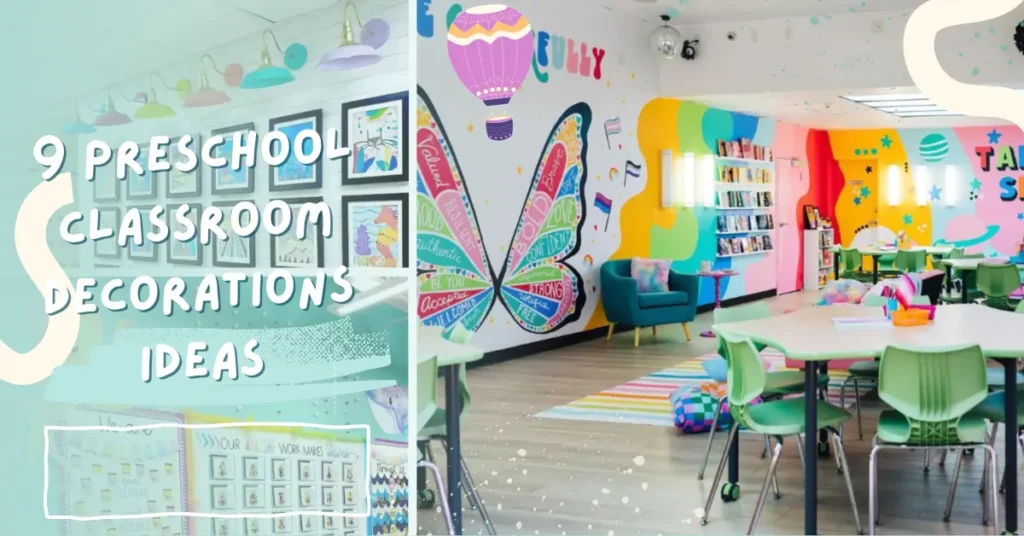In our previous post, “What Supplies You Need for Your Preschool Classroom,” we shared the essential supplies and materials for every preschool classroom. But isn’t your preschool classroom feeling a little drab? Looking for preschool classroom decorations ideas to create an inspiring learning environment for your little learners?
Preschool classroom decorations focus on creating colorful, interactive, and theme-based decorations that inspire learning and creativity.
If you’re a preschool teacher or administrator, you understand the importance of creating a welcoming and stimulating environment for your young learners. Preschool classrooms can’t just focus on curriculum education; environmental education is just as important. One way to accomplish this is through well-chosen preschool classroom decorations.
1. Preschool Classroom Decorations: Colors
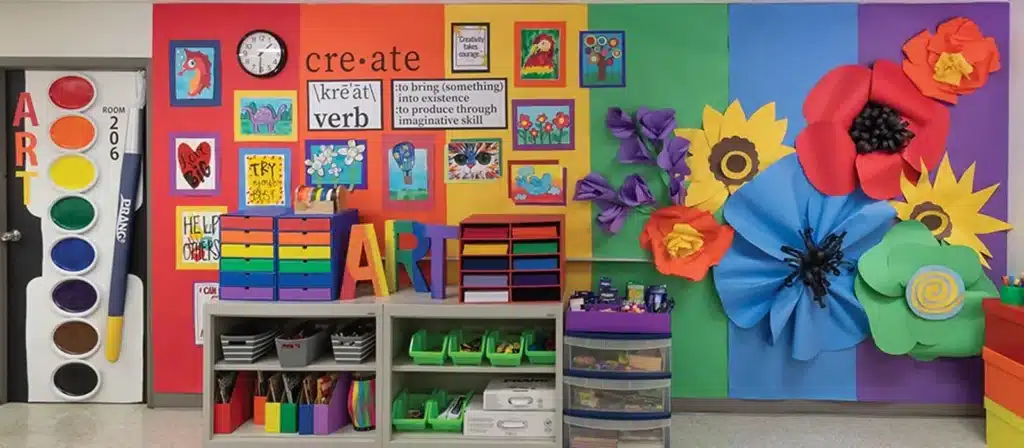
Colors play a vital role in preschool classroom decorations. They can influence mood, focus, and even behavior. What are the best colors for a preschool classroom?
- Warm Colors: preschool classroom decorations colors like red, orange, and yellow can energize and stimulate children, making them feel excited and ready to engage.
- Cool Colors: Blues and greens have a calming effect, which can help create a serene learning environment.
- Neutral Colors: These are great for balancing the vibrancy of other colors, ensuring the classroom isn’t overwhelming.
Implementing Colors Effectively
- Accent Walls: Use bold colors on one wall to create a focal point without overwhelming the room.
- Color Zones: Different classroom areas can have different colors to signify various activities, such as a blue reading nook or a yellow art corner.
- Furniture and Accessories: Use colorful furniture and accessories to add pops of color without permanent changes to the room
To decorate a balanced environment, consider combining bright and pastel colors. For example, you could paint the main walls in soft, soothing colors and use bright accents through the furniture and décor. This approach helps to stimulate children while also providing them with places where they can relax and focus.
Incorporate color through various elements, such as wall paint, furniture, carpeting and classroom supplies. Classroom decorating considers using colors to designate different classroom areas for specific activities, such as a red corner for art projects and a blue corner for reading. This not only adds vibrancy but also helps organize the space effectively.
2. Preschool Classroom Decorations: Lighting
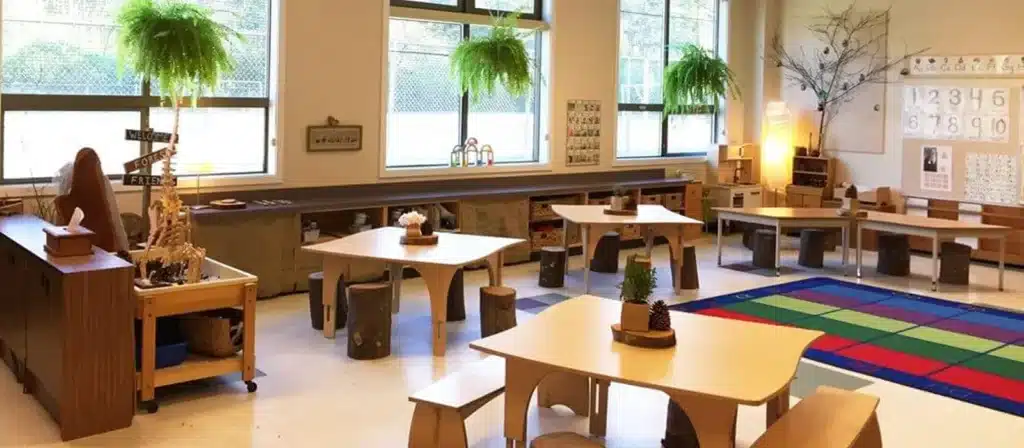
Natural light is the best choice for preschool classroom decorating as it has been shown to improve mood and productivity. Ensure your windows are clear to let in as much natural light as possible. Use light, airy curtains that allow light to filter through while still providing some shade.
You can add a touch of whimsy to your classroom with decorative lighting elements such as string or themed lights. These are particularly useful in creating cozy corners or highlighting specific areas, such as reading or art corners.
- Natural Light: Whenever possible, utilize natural light. It’s beneficial for mood and concentration.
- Soft Lighting: Use soft, diffused lighting to create a warm and inviting atmosphere. Avoid harsh, fluorescent lights that can be straining.
- Task Lighting: Provide lighting for specific activities like reading or art projects.
- String Lights: Soft string lights can add a whimsical touch and create a cozy atmosphere.
- Lamp Stations: Set up different lamps around the room for a more home-like feel.
- Light Tables: Incorporate light tables for sensory and exploratory activities, providing illumination and engagement.
3. Preschool Classroom Decorations: Wall Decoration
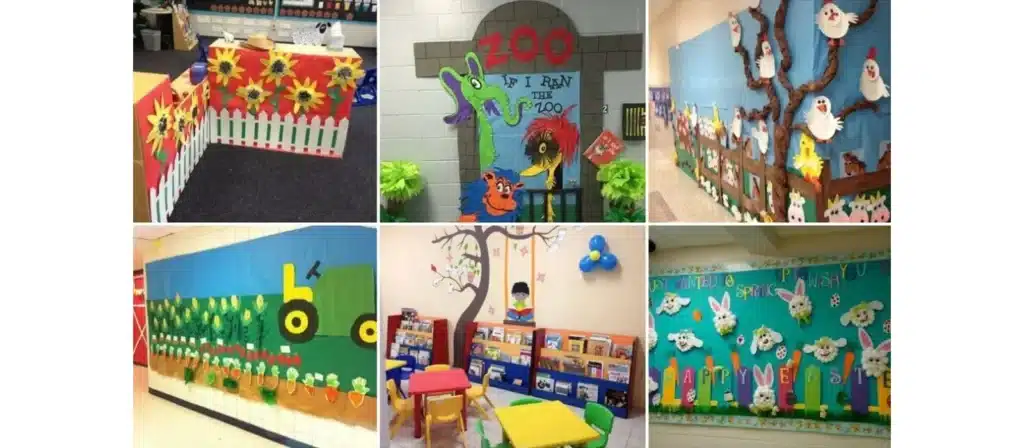
Walls offer a large canvas for creative and preschool room decorations. What are some effective wall decoration ideas?
- Murals and Decals: Use murals and wall decals to decorate themed areas like under the sea, jungle, or space adventures.
- Educational Posters: Display posters that teach alphabets, numbers, shapes, and colors.
- Interactive Walls: Incorporate interactive elements like Velcro boards, magnet walls, and sensory boards to engage children in hands-on learning.
- Rotating Displays: Change wall displays regularly to keep the classroom fresh and aligned with current learning themes.
- Student Contributions: Dedicate a wall section to display student artwork and projects. This not only decorates but also instills a sense of pride and ownership in the children.
- Themed Sections: Create wall sections for different subjects, such as a science corner with nature posters or a reading corner with literary characters.
4. Preschool Classroom Decorations: Bulletin Board
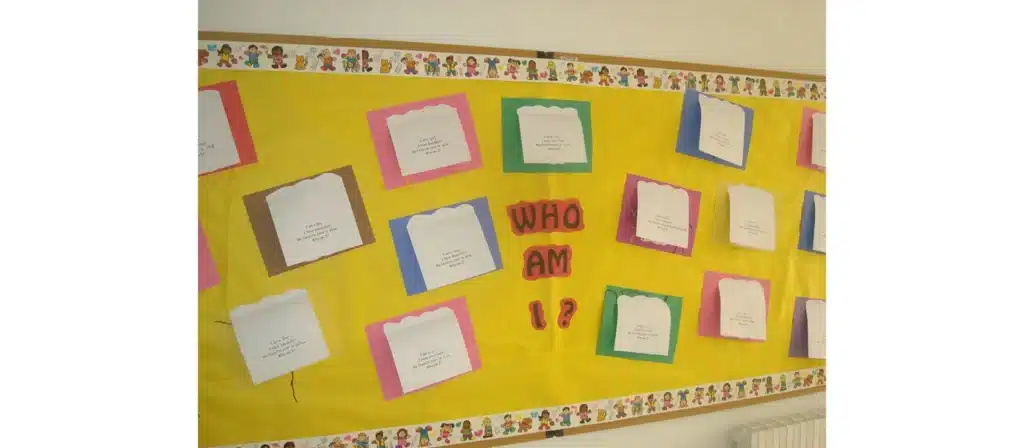
Bulletin boards are versatile tools that can be used for various purposes, from displaying student work to showcasing important information. They can display important information, student work, and thematic decorations. One idea is to create a seasonal bulletin board that changes with the seasons, featuring themes like autumn leaves, snowflakes, and spring flowers.
- Seasonal Themes: Change the bulletin board to reflect different seasons or holidays, incorporating relevant educational content.
- Interactive Boards: Create boards where children can add input, such as question-of-the-day or interactive storyboards.
- Learning Boards: Use bulletin boards to reinforce current lessons, such as a math board with counting games or a language board with new vocabulary words.
- Student Involvement: Allow students to help create and update the bulletin boards. This involvement can enhance their learning experience and make them feel valued.
5. Showcase Student Work
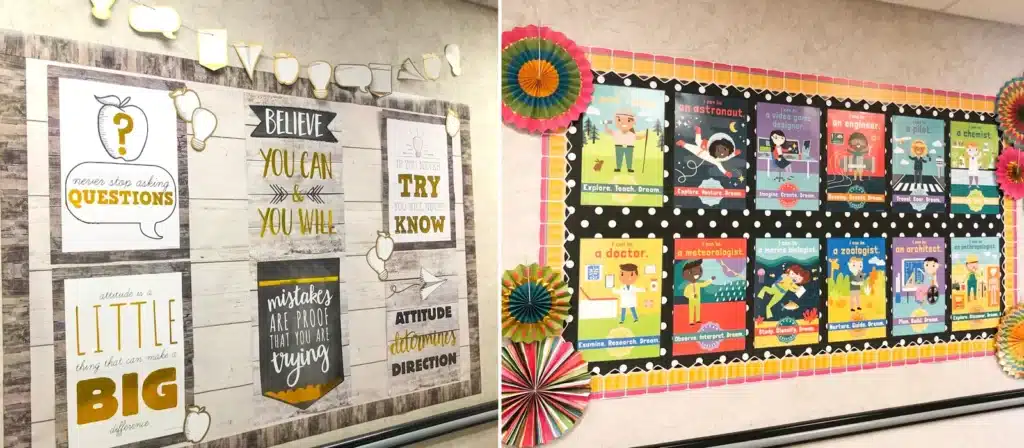
Showcasing student work is a wonderful way to decorate the classroom and boost children’s self-esteem. Dedicate specific classroom areas to display art projects, writing samples, and other achievements. Use frames, clipboards, or wire and clothespins to create a rotating gallery of student work.
Consider setting up a “Star of the Week” display where a different student is featured each week. This can include their artwork, a photo, and a short bio. It’s a great way to make each child feel special and recognized.
- Dedicated Display Areas: Designate specific classroom areas for showcasing student artwork, writing projects, and other creations.
- Rotating Exhibits: Regularly update the displays to highlight different students and projects, ensuring everyone can shine.
- Themed Galleries: Organize student work by themes or projects, such as a science fair section or a seasonal art gallery.
- Clipboards and Frames: Use clipboards, frames, or hanging wires to display artwork and assignments neatly and accessible.
- Digital Displays: Incorporate digital picture frames or projectors to showcase student work digitally, allowing for dynamic and varied presentations.
- Interactive Displays: Create interactive displays where students can leave comments or questions about their peers’ work, fostering a collaborative and supportive environment.
6. Overuse of Visual Aids

Visual aids are essential in preschool classroom decor, but too many can be overwhelming. How do we avoid overuse and still benefit from them?
- Selective Use: Choose visual aids that align directly with your teaching objectives. Too many visuals can distract rather than enhance learning.
- Clear Organization: Ensure that visual aids are well-organized and easily understandable. Group similar items together and avoid clutter.
- Interactive Elements: Incorporate interactive visual aids like flaps, wheels, or magnetic boards that children can manipulate to reinforce learning.
- Color Coding: Use color coding to help differentiate between different types of information, making it easier for children to process.
7. Avoid Chaos in Preschool Classrooms

A well-decorated classroom should be visually stimulating but not chaotic. A cluttered classroom can be distracting for young learners. To maintain an orderly environment, use storage solutions that keep materials organized and out of sight when not in use. Invest in shelves, bins, and cubbies that are easily accessible for children.
- Defined Areas: Create clearly defined areas for different activities, such as a reading corner, art station, and play area. Use rugs or furniture to demarcate these spaces.
- Storage Solutions: Ensure ample storage to keep materials organized and out of sight when not in use. Bins, shelves, and cubbies can help maintain order.
- Consistent Themes: Stick to a consistent theme or color scheme to create a cohesive look and feel.
- Label Everything: Label shelves, bins, and areas so children know where to find and return items.
- Routine Clean-Up: Incorporate clean-up times into the daily schedule to teach children responsibility and keep the classroom tidy.
- Minimalist Approach: Less can be more. Focus on quality preschool classroom decorations rather than quantity to avoid visual overload.
8. Preschool Classroom Decorations: Carpet
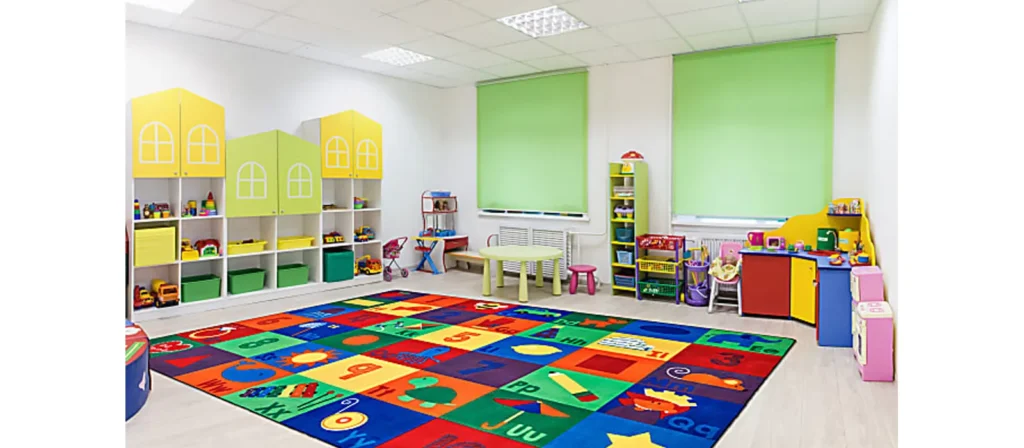
They provide a soft surface for children to sit on during circle time, reading sessions, and play activities. Choose carpets with bright colors and educational patterns like letters, numbers, or maps.
Ensure the carpet is easy to clean and durable, as it must withstand heavy use. Stain-resistant materials are a good option for a preschool setting. Regular cleaning and maintenance are crucial to keep the carpet looking fresh and hygienic.
Consider using multiple rugs to define different areas of the classroom. For example, a large rug for the main gathering area, smaller rugs for reading nooks, and a rug in the art area to protect the floor from spills. This not only adds visual interest but also helps organize the space.
9. Incorporate Natural Elements

Bringing elements of nature into the classroom can create a calming and nurturing environment. Use plants to add greenery and fresh air. Choose low-maintenance plants that are safe for children and can thrive indoors, such as spider plants, pothos, or succulents.
Natural materials like wood, stone, and wicker can add warmth and texture to the classroom. Consider wooden furniture, wicker baskets for storage, and natural fiber rugs. These elements create a cozy and inviting atmosphere.
Incorporate nature-themed decorations, such as posters of animals, leaves, and flowers. Use natural light as much as possible by keeping windows unobstructed and using light, airy curtains. This brightens the classroom and helps create a connection to the outside world.
- Calming Effect: Natural elements can reduce stress and create a serene learning environment.
- Hands-On Learning: Use nature corners where children can explore natural objects, such as leaves, rocks, and shells, fostering curiosity and exploration.
- Sustainability Lessons: Teach children about sustainability and the environment through using natural materials and conservation projects.

